


![]()
ONLINE
KPF’s Global Impact
Editors’ Note
In 1976, along with William (Bill) Pedersen and Sheldon (Shelly) Fox, A. Eugene Kohn founded KPF with the commitment to providing design and management excellence matched with technical proficiency and superior client service. Serving as Partner-in-Charge of many of KPF’s major domestic and international projects, he, in addition to his leadership roles, shaped the firm along with his original partners into one of the world’s leaders in all aspects of architectural practice. Kohn earned B.A. and M.A. degrees from the University of Pennsylvania and served in the U.S. Navy on Active Duty for three years between degrees, for five years on Reserve Duty, and retired as a Lieutenant Commander. He is an Executive Fellow of the Graduate School of Design at Harvard University and currently teaches at the Harvard Business School. He helped establish the Harvard International Real Estate Center and has served as a trustee for the University of Pennsylvania. He is also a founding member of the Wharton Real Estate Center Advisory Board. He was honored most recently with the Soane Foundation Honors and the 2010 Alumni Award of Merit by the University of Pennsylvania – the highest university-wide award presented to alumni by Penn.
Company Brief
Operating as one firm with six global offices, KPF’s (www.KPF.com) 600 staff members come from 43 different countries and speak more than 30 languages. The firm’s diverse portfolio features over 70 projects certified or pursuing green building certification and comprises corporate, hospitality, academic, medical, research, civic, transportation, residential, and mixed-use projects located in more than 35 countries.
What makes Kohn Pedersen Fox so special and how have you achieved so much success?
Over the years, a number of forces have helped the firm achieve many goals, including growth and a significant degree of success.
It starts with dynamic leadership at many levels. This year on July 4th, the firm celebrated its 36th anniversary. The make-up of KPF today includes two of the three original founding partners, Bill Pedersen and myself along with Bill Louie, who joined us just two years after our start and is still fully involved. Unfortunately Shelly Fox, the third founding partner, passed away in December 2006.
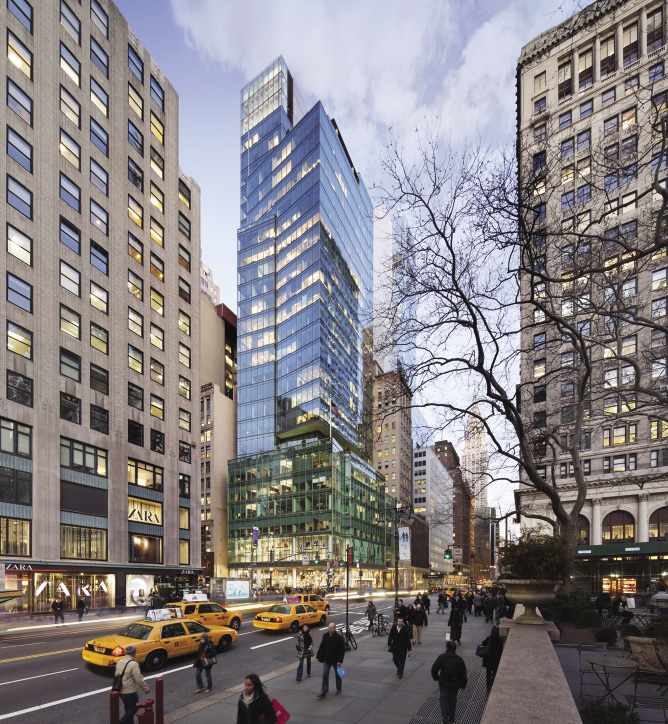
505 Fifth Avenue, developed by Kipp Stawski
There are another three generations of principals who contribute to the excellence of the firm, including but not limited to the current leaders Paul Katz, Managing Principal, and James von Klemperer, Design Principal; there are 23 principals in total. It is this vital integration of knowledge and experience combined with the youthful energy and talent that makes for a dynamic and well-balanced firm.
We also have a diversity of experience, both global, which is critical to our success, and typological. KPF’s extensive international experience encompasses a wide range of building types including residential, hotel, retail, mixed-use, educational, health care, airport, transportation, museum, and cultural, from low-rise to super-tall, from new construction to renovation. And there is not a project type that KPF has designed that a senior staff member or principal has not worked on. We have not just developed knowledge; we have kept it at KPF.
We have been fortunate over the years to have been selected by excellent clients and have in turn designed significant structures for them that are relevant for their respective cities. KPF has executed over 320 structures that have increased in value for their owners. As a result, we have established an outstanding reputation. Our clients come from both the private and public sectors, and include commercial development, corporate, educational, institutional, transportation, and government facilities.
In addition, we have a quality staff. Fundamental to KPF’s success and future is our staff and its exceptional talent. Every year we recruit the top graduates and guide and mentor them to be the best they can be. We also identify future leaders in our young people.
I believe that our firm’s approach to team effort by sharing credit and success and encouraging young people to grow and ultimately become principals has created a wonderful spirit, allowing the firm to perform in an excellent way. Also, by working globally during slow periods in the U.S., we have remained viable, gained enormous knowledge, and built a very strong and experienced staff.
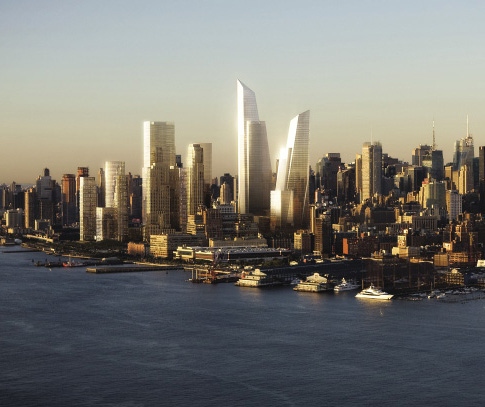
Hudson Yards, developed by Related
KPF has been instrumental in the development of many buildings in New York City. Would you highlight some these projects and your outlook for growth in the market?
KPF has designed buildings in more than 35 countries – many of which are significant icons in their respective cities. We have enjoyed working in Hong Kong, China, Korea, India, Singapore, and throughout Asia as well as in the United Kingdom, Europe, the Middle East, Australia, Brazil, Chile, Canada, and others.
As exciting as it is to work in foreign countries, it is still most rewarding to work in the United States, particularly in New York City and New York State where we have completed more than 60 projects. Our first projects in New York were for the American Broadcasting Company on New York’s Upper West Side. Some examples of over 36 years’ worth of work in New York include 712 Fifth Avenue; 1325 Avenue of the Americas; 745 Seventh Avenue – originally Morgan Stanley, then Lehman Brothers, and now Barclays Headquarters; 505 Fifth Avenue – an exciting office building for the CIT Group; and, most recently, One Jackson Square, an award-winning residential building.
Currently, we are working on the Hudson Yards, having designed the 12-million-square-foot master plan of office, retail, residential, and hotel space. Within our master plan, we are currently designing the first two office towers. We are also designing another office tower on 33rd Street, just north of the rail yards. In addition, KPF is doing two new residential buildings, 27 Wooster Street and another along the High Line. We have done a number of renovations and upgrades to existing buildings such as 640 Fifth Avenue, 1515 Broadway, and 280 Park Avenue. Most recently, we were commissioned for a special new office building in midtown.
New York has recently shown encouraging signs for new development and developers are increasingly optimistic, hoping the economy gets stronger so potential tenants who need more space have the confidence to make their moves.
I am also optimistic for New York City’s continued growth in the real estate arena as well as KPF’s involvement in that growth.
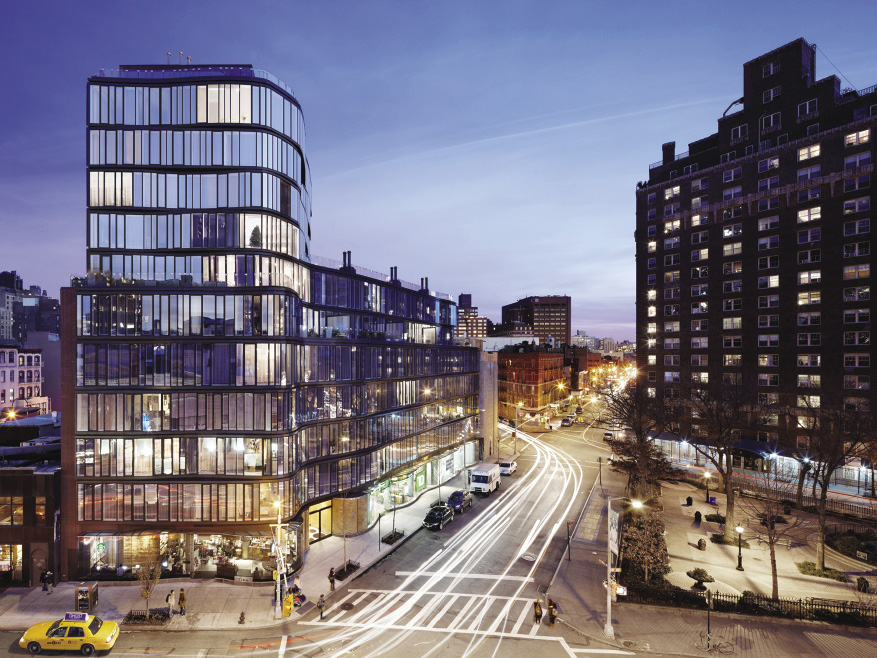
One Jackson Square, developed by Hines and RFR Holding Corp.
KPF is involved in the development of Hudson Yards. What is your outlook for that project and the impact it will have on New York City?
Hudson Yards – from 30th to 33rd Street and 10th to 12th Avenue – is being developed by Related Companies and Oxford Properties Group and includes terrific office, residential, hotel, retail, cultural, and academic facilities surrounding wonderful public spaces varying in size, surface materials, and landscaping. The area is served by Penn Station, the Port Authority Bus Terminal, and the extension of the 7 Train Line – right to 33rd Street between 10th and 11th Avenues. For pedestrian access, the High Line connects to this development at 30th Street, just west of 10th Avenue.
We are currently designing two large office towers and the retail enclosure, which totals approximately 5 million square feet. With great new buildings, major public spaces – hard and green surfaces, fine retail, food and dining, a school, cultural facilities, excellent views, and very good transportation, the project promises to be a great success. It already is attracting major tenants and is a favorite of Mayor Bloomberg.
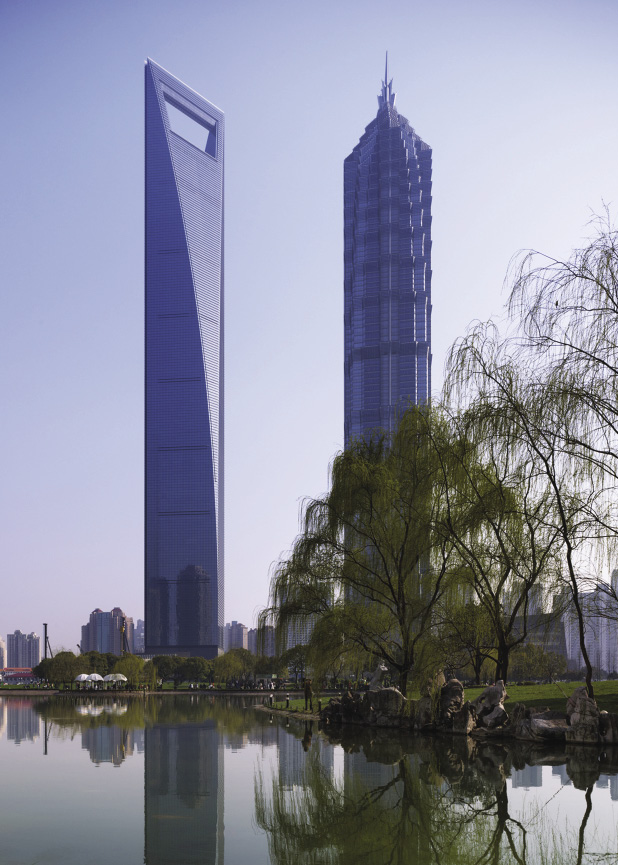
Shanghai World Financial Center,
developed by Mori Building Company
You have experienced strong growth internationally. Which key markets is KPF focused on overseas?
In 1985, I was at an Urban Land Institute (ULI) Conference where an economist addressed a large audience of real estate developers and brokers, bankers, architects, engineers, and others. He said that if we were not global by 1990, half of the audience would be out of business.
I took the speaker seriously, as if he was addressing me personally. When I returned to the office, I met with Shelly Fox and Bill Pedersen to discuss this issue, and we agreed that we needed to look at working overseas.
We decided that the U.K. and Europe would be a good place to start. I learned that Goldman Sachs was going to build a new headquarters in London and I was fortunate to know the partner heading up real estate. Through him, we got an interview and were eventually selected to design the buildings in a most sensitive area of London – sensitive due to historic issues and views of St. Paul’s. We were successful in getting the project approved and even managed to increase the proposed building’s total area. This headquarters building is still an excellent asset for Goldman Sachs, as they have expanded around it.
Shortly after our selection by Goldman Sachs, we won a competition to design a major office building in Frankfurt, now the DZ Bank Headquarters. We were also commissioned to do a building at Canary Wharf. This was the catalyst for our London office, which is still busy with work in the United Kingdom and Europe, as well as in India, China, and the Middle East.
At about the same time in the late ’80s, we received a call from the Taisei Corporation, a Japanese client we worked for in Chicago with the Palmer Group designing 225 West Wacker Drive. They invited us to Tokyo to enter a competition with them. They eventually decided not to pursue this competition, but recommended KPF for an enormous project in Nagoya for JR Central – a new train station with five million square feet of office, retail, hotel space, and more over the tracks. We were eventually selected and worked with Taisei to complete this exciting project over 10 years. Today, we are working on adding over 2.8 million square feet to this project some 22 years later.
In addition to the JR Central Towers and Station, we have completed a number of other projects in Japan. This includes the INCS Zero Factory in Nagano and Roppongi Hills in Tokyo, which comprises a 3.8-million-square-foot office building featuring a wonderful museum at the top, as well as a Grand Hyatt Hotel, which includes a ballroom, meeting rooms, restaurants, wedding chapel, and more – there is also the structure for the movie theatres. In addition, we designed the Merrill Lynch Tokyo Headquarters. Our current work includes an office building under construction and a mixed-use project – the former Prince Hotel – in design; both projects are in Tokyo.
We used these early trips to Japan to visit and pursue work in Hong Kong with Hongkong Land, which eventually led to work there and throughout Asia, starting with the total renovation of The Landmark in central Hong Kong, as well as Plaza 66, a large-scale development in Shanghai that includes two major office towers and five levels of high-end retail, developed by Ronnie Chan of Hang Lung Properties. This project led to our designing the Shanghai World Financial Center for Mr. Mori, who recently passed away. It is a 4.1-million-square-foot, mixed-use tower, which is still the tallest in Shanghai. We had been working for Mr. Mori designing Roppongi Hills at the time.
In Korea, we master-planned a new city – Songdo City – in Incheon with Gale International and Posco E&C, and designed a number of corporate headquarters, some completed, others under construction.
Singapore and India remain strong markets, as well as Kuala Lumpur and Jakarta. Our work in the Pacific has stretched as far as Sidney, Australia.
KPF is also busy in the Middle East. Our first building in Abu Dhabi was the ADIA Headquarters and we are currently designing the new international airport there, which is about to start construction, as well as working in Dubai and Qatar. More recently, we have expanded our practice in Brazil with a number of buildings going up in Sao Paulo and Rio de Janeiro, and we have an exciting potential project in Santiago, Chile.
KPF has done a number of major projects in Canada over the years. We completed the IBM Headquarters in Montreal in 1992. The building still remains a favorite and was voted the best building in Canada over the past 25 years at its time of completion. Most recently in Toronto, we completed the RBC Centre Headquarters for Cadillac Fairview and the new Ritz-Carlton Hotel and Residences for Graywood Developments. In addition, we have a new office building in Montreal in design for Cadillac Fairview, and for Oxford Properties, we are working on a major tower in Toronto as well as an office building in Vancouver, currently under construction.
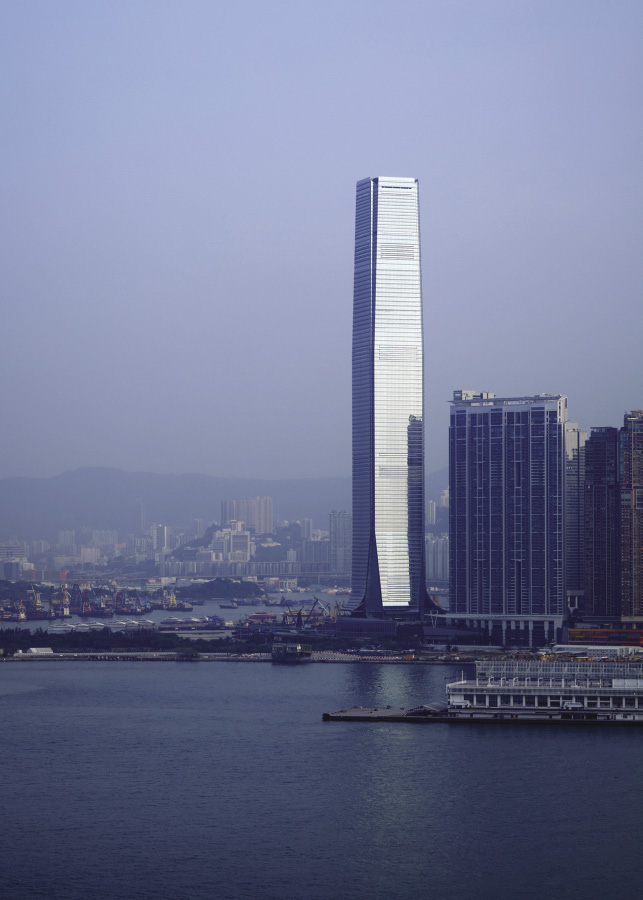
International Commerce Centre, Hong Kong
developed by Sun Hung Kai Properties
Would you provide an overview of the new buildings KPF has designed in China and how the firm is playing a role in structuring the landscape for China’s future?
KPF is currently working in 18 cities in China with the firm designing significant, super-tall towers and large-scale, mixed-use projects throughout Hong Kong, Shanghai, Beijing, Shenzhen, Tianjin, Hangzhou, Chongqing, Chengdu, Harbin, and others. Developed by the Mori Building Company in Shanghai’s Pudong Lujiazui District, the 492-meter Shanghai World Financial Center has become the most famous tower in China, with the Park Hyatt Hotel and an observation deck at the very top. Now buildings are even taller. KPF is currently working on the Ping An insurance tower in Shenzhen, which will be over 660 meters when completed in 2016.
Many of KPF’s new buildings are super tall, and are creating and changing the skylines of their respective cities, while also providing modern office and residential facilities for China’s rapidly growing urban population. We are also very concerned about these cities at the street level and about the public spaces being created by new buildings.
I believe that KPF has had the most impact of any foreign architect in China, contributing significantly to its growth and development by bringing to it quality architecture and an improved built environment in an era of unprecedented population migration.
Other parts of Asia have also provided opportunities for KPF, including South Korea, Singapore, and Hong Kong. What is your involvement in these countries?
KPF has been fortunate in that all of Asia has remained a strong market for us. In fact, South Korea, Singapore, and Hong Kong are some of the strongest locations that we are currently working in.
In Hong Kong, we recently completed the 490-meter International Commerce Centre, the fifth tallest building in the world. The tower is fully leased to Morgan Stanley, Credit Suisse, and Deutsche Bank, with a magnificent Ritz-Carlton Hotel at the top – the views in all directions from the bar on the 118th floor are phenomenal. The building is located over the train station with connections to the airport and Hong Kong Island.
In addition, Hysan Place – a project with 17 floors of retail and 19 floors of office space above – has recently had its grand opening. KPF has had a long and successful history with exceptional clients in Hong Kong, designing different types of projects, including office; retail –The Landmark; and hospitality – The Landmark Mandarin Oriental.
South Korea is a country of 43 million people, which has seen extensive development over these past 20-plus years, particularly in the CBD of Seoul. KPF most recently designed a super-tall tower with extensive retail and entertainment for Lotte – 5.3 million square feet and 555 meters high, it is currently under construction. We have also completed the 1,500-acre master plan for New Songdo City near Incheon, where we have designed about 20 buildings, including a convention center, numerous residential buildings, an international school, several office buildings, and the Northeast Asia Trade Tower. Additional projects in South Korea include the Samsung Seocho Headquarters, Rodin Pavilion at Samsung Plaza, Yuksamdong, Dongbu Financial Center, Posteel Tower, and Ilsan Cultural Center.
Since the completion of the Orchard Building Redevelopment, KPF has had an ever-growing presence in Singapore. Our completed projects there include 30 Hill Street, the Singapore Exchange Centre, One Raffles Link, One Raffles Quay, and the four-million-square-foot Marina Bay Financial Centre, the first development in the city’s new Marina Bay district. KPF’s current work in Singapore includes the nearby Marina Bay Suites tower, which will open in 2013.
You have been heavily engaged in London with a number of projects. What opportunities does London offer for growth and what are your current actives in the market?
The London market, similar to New York, is showing increasing promise, although the tenants, who need additional space and whose leases are due in a few short years, are still slow to take up space in the proposed new towers because they lack confidence. It is still a relatively strong market but will be better when the Euro is stabilized and the rest of Europe shows signs of growth.
We recently finished the Heron Tower for Gerald Ronson, a very successful tall tower in the heart of London. The Unilever London Headquarters renovation has been a spectacular transformation; it was completed in 2007 and is a fantastic place to work.
KPF is now working on a number of residential towers as well as an office building in Canary Wharf where we have designed about seven buildings. In addition, we have three other office buildings in London including a new faceted, 190-meter tower at 52-54 Lime Street, opposite the Lloyd’s Building, for W.R. Berkley and Property Group Partners. We are also working at Earls Court and Covent Garden for Capital & Counties. The London office also stays busy with projects in India, China, and the Middle East, particularly with the new airport in Abu Dhabi.
How special is it to work in New York City and to be such a major part of the New York City landscape?
It is always special to design in New York City and to work with many of the city’s leading developers, corporations, and institutions. It is KPF’s home, our headquarters, where our families and many of our friends live. We can also observe the construction of our projects without traveling and witness how each building is received and used.
We have had the privilege to work with many excellent New York developers including the Related Companies, as well as SL Green, Vornado Realty Trust, Boston Properties, Tishman Speyer, Hines, the Taubman Company, Extell Development, LeFrak Organization, Rockefeller Group, Kipp-Stawski, and Sherwood Equities. Just across the river in New Jersey, we have worked with the LeFrak Organization, Hampshire Properties, and Rockefeller Group.
All of us at KPF like to feel we are making a significant contribution to our city – New York.
Many of the business leaders in New York City refer to the strength of the public/private partnership and the value of a mayor like Michael Bloomberg who understands the needs of business leaders. How critical has this been to the strength of the city?
The key to successful growth for businesses in the city is a result of strong leadership that inspires the public and private sectors to work together. New York has benefited from the strong leadership of Mayor Bloomberg and his vision for the city. He understands the needs of businesses and of growth, and an improved quality of life for its people. His vision for New York City is epitomized by the Hudson Yards project, which is just one of many good examples. New York is a place that needs bold moves to lead the city forward and to maintain its strength. Under the leadership of Amanda Burden, City Planning has also contributed to the growth opportunities and toward improving the quality of New York’s built environment. As a result of Mayor Bloomberg’s leadership, the city is an exciting place to live and work – full of energy and hope for the future.
KPF is heavily engaged in many charitable causes in New York City. How important is this to the culture of the firm?
Architects work long hours – many nights and weekends – in a creative process. However, we do believe in being good citizens and in doing our best to help others, leading by example in a number of ways. The firm participates in many charitable and educational organizations. We include staff, when possible, to join in these charitable dinners and events, and encourage their getting involved in the community as well. We consider community involvement a critical dimension of our work, and try to give back by passing on our comprehensive knowledge of large buildings and urban planning to the architecture community. We do this partly through teaching at universities and speaking frequently at lectures and conferences. We have long established regular intern relationships with educational institutions in the U.S. and Canada, as well as in Japan, Korea, China, and Chile.
In addition, KPF is a sponsor of the Green Building Council: the UGC (New York), UKGBC (United Kingdom), and HKGBC Hong Kong. We participate in the ACE Mentor Program, a not-for-profit organization that helps prepare high school students for careers in design and construction. We also offer a travelling fellowship program each year, a Student Travel Award organized by The Architecture Foundation, and a year-long externship Construction Company Training Program in collaboration with various construction companies.
I have personally raised money through several exhibitions of my watercolors, and on behalf of the firm, for cancer research. I also sponsor a scholarship fund at the University of Pennsylvania and the firm has a number of scholarships it supports. KPF recently made a major gift to a real estate and design program at Columbia University. I believe that, as architects, our greatest contribution though is through our work – helping to improve the quality of life for people as well as the built environment in our communities and cities.
What are the key priorities for the future to maintain your leadership position in the industry?
KPF’s success is a direct result of the quality of our work and our people, as well as inspirational leadership at many different levels. The key is our talented, creative, and committed employees, who are eager to learn and to improve as we look to the future and to another 36 years or more of success.
We will continue to stress and improve the quality of our design and our understanding of our clients’ needs, as well as our performance and service to these clients. As an international firm with a diverse portfolio of program types, KPF is, and will continue to be, ideally positioned to take advantage of the most current practices and technologies. This position will allow KPF to provide the best performing buildings to our clients and the communities we work in.
KPF has depended on the outstanding clients we have been fortunate to attract around the world. I believe as architects we can and do create great value through our designs for commercial and corporate clients, and at the same time, these buildings contribute positively to their cities and to their sites.
We want to make a difference.•